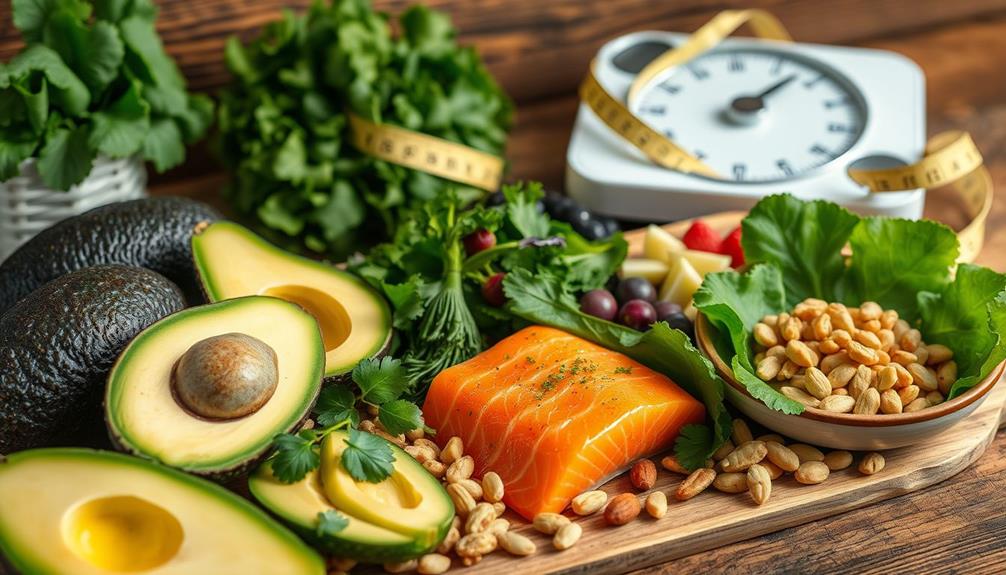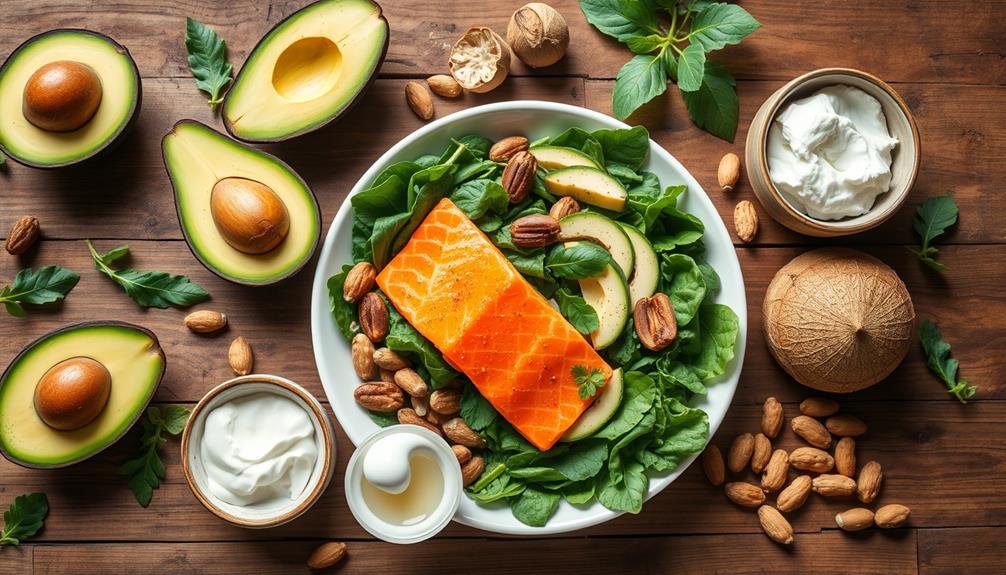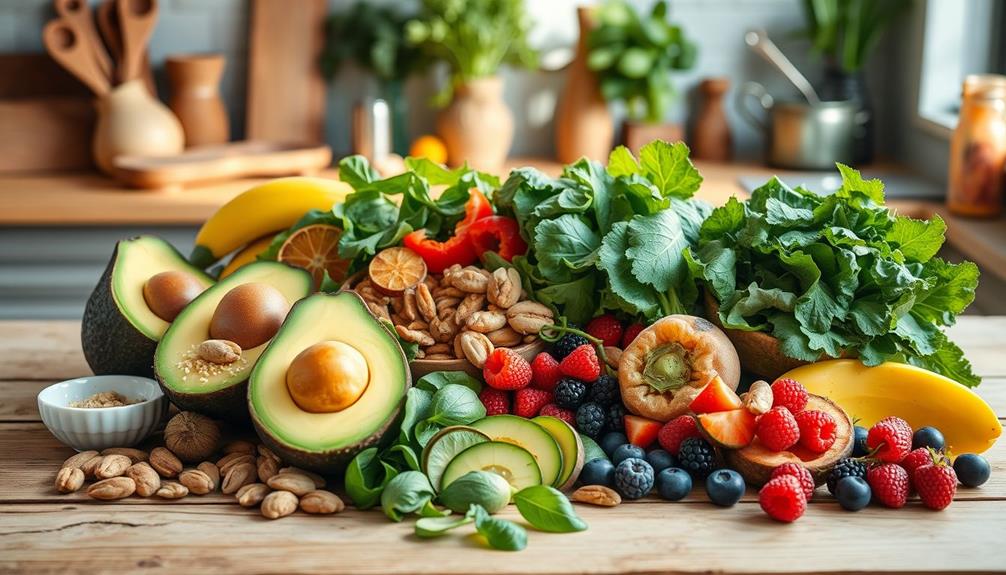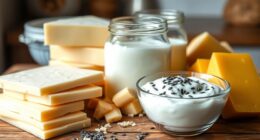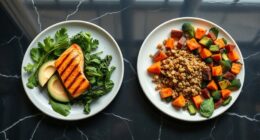To lose weight on the keto diet, you'll want to reduce carbs and increase your fat intake. Aim for a macronutrient ratio of about 70-75% fat, 20-25% protein, and 5-10% carbohydrates. Keep your daily carbs between 20-50 grams to achieve ketosis, which helps burn fat for energy. Focus on healthy fats like avocados and olive oil, and choose low-carb veggies and high-quality proteins. Planning your meals is essential to stay on track and avoid impulsive eating. Staying consistent and monitoring your progress will amplify your results. There's a lot more to discover on optimizing your success.
Key Takeaways
- Follow a macronutrient ratio of 70-75% fats, 20-25% protein, and 5-10% carbohydrates to achieve and maintain ketosis.
- Prioritize whole, unprocessed foods, such as healthy fats, low-carb vegetables, and high-quality proteins, to ensure nutrient density.
- Plan meals ahead to keep carbohydrate intake within 20-50 grams daily and prevent impulsive eating.
- Stay hydrated and maintain electrolyte balance to alleviate keto flu symptoms during the transition.
- Incorporate regular exercise, combining cardio and strength training, to enhance fat loss and overall metabolism.
Understanding the Keto Diet

What does it really mean to follow a keto diet? The ketogenic diet is all about notably reducing your carbohydrate intake and replacing it with fat. You'll typically aim for a macronutrient ratio of about 70-80% fat, 15-25% protein, and only 5-10% carbohydrates. This shift pushes your body into a metabolic state known as ketosis, where it starts burning fat instead of carbs for energy.
Additionally, incorporating foods rich in antioxidants can complement your diet by promoting overall health, similar to how cranberry juice consumption offers benefits.
To reach ketosis, you'll need to limit your carbohydrate intake to about 20-50 grams per day. When you do this, your liver converts fatty acids into ketones, which then become your brain's and body's new energy source. You might notice some common signs of ketosis, like increased thirst, reduced hunger, and even a distinct "keto breath."
Originally designed in the 1920s for epilepsy treatment, the keto diet has gained traction as a popular weight-loss strategy. It often leads to quicker weight loss compared to traditional low-fat diets.
To stick with the keto diet, careful meal planning is essential, focusing on high-fat foods like avocados and nuts while steering clear of grains, sugars, and starchy vegetables.
Macronutrient Ratios for Success

Achieving success on the keto diet hinges on the right macronutrient ratios. You'll want to aim for approximately 70-75% fats, 20-25% protein, and just 5-10% carbohydrates. This balance is essential for entering and maintaining ketosis, where your body becomes a fat-burning machine.
By limiting your carbohydrate intake to about 20-50 grams per day, you greatly reduce reliance on glucose for energy. Incorporating effective strategies for weight loss will further enhance your journey.
Here are some key points to keep in mind:
- Prioritize high-fat foods like avocados, olive oil, and nuts.
- Moderate your protein intake to around 1.2 to 1.7 grams per kilogram of body weight.
- Use a keto calculator to monitor your macronutrient ratios effectively.
- Celebrate small victories; every ounce lost is progress!
- Remember that consistency is key to experiencing the benefits of fat metabolism.
Importance of Meal Planning

Meal planning is essential for successfully following the ketogenic diet. It helps you control your carbohydrate intake to the recommended 20-50 grams per day, ensuring your body stays in ketosis. When you prepare meals ahead of time, you avoid the temptation of impulsive eating and can focus on whole, nutrient-dense foods like avocados, nuts, and low-carb vegetables.
Additionally, maintaining a budget for your keto groceries can aid in managing your finances while pursuing a healthier lifestyle budget plan for groceries.
Research shows that structured meal planning leads to better weight loss outcomes. By planning, you engage in more mindful eating and portion control, which aids in creating a calorie deficit. This structured approach makes it easier to track what you eat and helps you stick to your goals.
Incorporating a variety of keto-friendly recipes into your meal planning can prevent dietary monotony, making it simpler to adhere to the diet long-term.
Plus, effective meal prep enhances your time management; you'll have convenient low-carb options ready on busy days, reducing the likelihood of reverting to processed or high-carb foods.
Healthy Food Choices

When it comes to the ketogenic diet, making healthy food choices is vital for your success. To thrive on keto, focus on incorporating healthy fats, low-carb vegetables, and high-quality protein into your meals.
Understanding different brewing methods can also help enhance your coffee experience without adding unnecessary carbs. These choices not only support ketosis but also help you feel satisfied and energized.
Here are some great options to take into account:
- Healthy fats: Avocados, olive oil, nuts, and seeds to keep your energy levels up.
- Low-carb vegetables: Spinach, kale, and broccoli to boost your fiber intake while staying within carb limits.
- High-quality protein: Fatty fish, grass-fed meats, and free-range eggs to guarantee you're getting the nutrition you need.
- Whole foods: Opt for fresh, unprocessed ingredients that nourish your body.
- Moderation: Avoid processed foods and sugars, as they can sabotage your efforts and lead to weight regain.
Utilizing an online keto calculator can help you track your macronutrient intake accurately, making sure you stay within the recommended 20-50 grams of carbs per day.
Common Challenges Faced

Starting a ketogenic diet can be a transformative experience, but it often comes with its share of challenges. One of the first hurdles you might encounter is the "keto flu." As your body adjusts to burning fat for energy instead of carbohydrates, you may experience fatigue, headaches, nausea, and irritability. This shift can make it tough to stick to the diet.
It's vital to stay hydrated and consider incorporating natural remedies, such as common types of cold medications that might help ease some discomfort during this adjustment period.
Meal planning becomes critical, yet it can be difficult to adhere to the strict carbohydrate limit of 20-50 grams per day. You may find yourself struggling with food choices, which can lead to frustration. Additionally, high-calorie keto foods, like nuts and avocados, can easily lead to overeating if you don't practice portion control, hindering your weight loss goals.
The monotony of limited food options can also lead to boredom, making long-term adherence challenging. Furthermore, psychological challenges, including cravings for high-carb foods and emotional eating, can arise.
To succeed on your keto journey, it's important to develop strategies to manage hunger and cravings effectively. By addressing these common challenges, you'll set yourself up for a more successful and enjoyable keto experience.
Managing Keto Flu Symptoms

When you start the keto diet, managing hydration and electrolyte balance is essential to combat keto flu symptoms.
Incorporating essential oils like eucalyptus oil can also support respiratory health during this shift.
Make sure you drink plenty of water and consider adding electrolytes to your routine.
Additionally, gradually reducing carbs can help ease your body into this new way of eating and minimize discomfort.
Hydration and Electrolyte Balance
Maintaining proper hydration and electrolyte balance is essential to managing the initial challenges of the ketogenic diet, commonly known as "keto flu." As your body shifts into ketosis, it can experience increased water loss due to lower insulin levels and depleted glycogen stores. This is why staying hydrated is vital.
It's important to remember that financial considerations for elderly care, such as understanding assisted living expenses, can also be impacted by health and lifestyle choices, including diet and hydration. financial considerations for elderly care can play a significant role in overall well-being.
To help you combat those pesky keto flu symptoms, keep an eye on your hydration and electrolyte levels. Here's what to focus on:
- Drink at least 8-10 cups of water daily.
- Incorporate foods rich in sodium, potassium, and magnesium, like leafy greens, avocados, nuts, and seeds.
- Consider bone broth for both hydration and electrolytes.
- Stay alert for signs of dehydration such as fatigue and headaches.
- Supplement electrolytes if necessary, especially during intense workouts.
Gradual Carb Reduction
Gradual carb reduction is an essential strategy for easing into the ketogenic diet and minimizing the dreaded "keto flu." By slowly decreasing your carbohydrate intake over 1-2 weeks, you can help your body adapt to ketosis without overwhelming it.
Incorporating gentle stretching before bedtime can also promote relaxation during this shift, especially if you're experiencing tension or discomfort. Aim to cut back by about 10-20 grams of carbs per day; this gradual approach can greatly lessen symptoms like fatigue, headache, and nausea.
During this shift, staying well-hydrated is imperative. Maintain your electrolyte balance by ensuring you get enough sodium, potassium, and magnesium. This can alleviate some keto flu symptoms and support your overall well-being.
For additional wellness tips, consider exploring yoga for back pain to enhance your comfort during this period.
Incorporating moderate exercise, such as walking or light resistance training, can also be beneficial. It promotes energy levels and boosts your mood, making the adaptation phase easier.
Don't forget to consume adequate amounts of healthy fats and protein during your gradual carb reduction. This will stabilize your energy levels and help curb cravings, paving the way for a smoother shift into ketosis.
Incorporating Exercise

Incorporating exercise into your ketogenic lifestyle can greatly amplify your weight loss efforts. Regular physical activity not only enhances fat loss but also boosts your metabolic rate while you're on the ketogenic diet.
Individuals with BPD often experience intense emotional responses, making physical activity a beneficial outlet for managing emotions and improving overall mental health. By combining cardio and strength training, you can experience improved body composition, increasing muscle mass while reducing body fat percentage.
Consider these benefits of exercise on your weight loss journey:
- Increased fat burning: HIIT workouts can help you burn fat while preserving lean muscle.
- Reduced muscle loss: Consistent activity mitigates potential muscle loss during weight loss.
- Improved insulin sensitivity: Exercise enhances your metabolic health, essential for a low-carb, high-fat diet.
- Enhanced mood: Physical activity releases endorphins, keeping you motivated and focused.
- Boosted energy levels: Regular exercise can elevate your overall energy, making it easier to stick to your plan.
To maximize your ketogenic diet's benefits, make exercise a non-negotiable part of your routine.
Whether it's a brisk walk, a lifting session, or a HIIT class, every bit counts toward your weight loss goals. Get moving, and watch your results soar!
Tracking Your Progress

Tracking your progress on the keto diet is key to staying motivated and making necessary adjustments.
Just like how thematic coherence is important in album structures, maintaining a consistent tracking routine can help you stay aligned with your goals. You should regularly monitor your weight, check your ketone levels, and keep a food diary to guarantee you're hitting those macronutrient targets.
Weight Measurements Frequency
Measuring your weight regularly is essential for monitoring your progress on the keto diet. It's often recommended to weigh yourself once a week. This helps you avoid getting caught up in daily fluctuations caused by factors like water retention and muscle gain.
To guarantee consistency, take your measurements at the same time each week, ideally in the morning after using the restroom and before eating or drinking.
Consider these additional methods to enhance your progress tracking:
- Track your waist, hips, and thighs for a broader perspective on weight loss.
- Take progress photos to visually document your transformation.
- Keep a journal or use a tracking app to log weight and measurements.
- Understand that weight loss isn't always linear—expect plateaus and fluctuations.
- Celebrate non-scale victories, like increased energy or better-fitting clothes.
Ketone Level Monitoring
Monitoring your ketone levels is vital for ensuring you're in ketosis and maximizing your fat-burning potential on the ketogenic diet. You can track these levels using urine strips, breath analyzers, or blood ketone meters, with blood measurements being the most accurate method.
For nutritional ketosis, ideal blood ketone levels typically range from 0.5 to 3.0 millimoles per liter (mmol/L).
During the initial stages of your keto journey, urine testing can be effective, but keep in mind that ketone levels in urine may decrease after several weeks.
Regular monitoring helps you adjust your dietary intake, ensuring you maintain ketosis and enhance fat burning. This consistent tracking is vital not just for ketone levels but also to improve your overall weight loss progress.
Food Diary Usage
Keeping a food diary is a powerful tool for anyone on the keto diet. By tracking your daily carbohydrate intake, you can guarantee it stays within the recommended 20-50 grams, which is essential for maintaining ketosis.
Documenting your food choices helps you identify patterns and potential triggers for cravings, ultimately leading to better meal planning and portion control.
Here are some benefits of keeping a food diary:
- Enhances accountability: You're more likely to stick to your goals when you see your choices laid out.
- Motivates progress: Watching your weight loss unfold can be incredibly motivating.
- Identifies triggers: Understanding what leads to overeating can help you make better decisions.
- Monitors macronutrient ratios: Making sure you hit that 70% fat, 25% protein, and 5% carbohydrates ratio becomes easier.
- Simplifies tracking: Using apps or online tools can streamline the process and provide quick access to nutritional information.
Staying Hydrated and Balanced

Staying properly hydrated is essential when you're on a ketogenic diet, as your body tends to lose more water and electrolytes during ketosis. To support your metabolic processes and maintain hydration levels, aim to drink at least 2-3 liters of water daily. This helps counteract the dehydration that can come with a low-carb regimen.
Incorporating electrolyte-rich foods into your meals can also be beneficial. Foods like avocados and leafy greens provide crucial sodium, potassium, and magnesium, which help mitigate "keto flu" symptoms.
Additionally, consider adding bone broth or electrolyte supplements to your routine; these can replenish lost minerals and fluids, boosting your overall hydration and well-being on the keto diet.
Don't forget to monitor your hydration status by checking the color of your urine. A pale yellow hue indicates proper fluid intake, while darker shades may signal the need for more water.
Staying hydrated and balanced won't only support your weight loss efforts but also enhance your energy levels and overall health on your keto journey. Remember, prioritizing hydration is key to your success!
Long-Term Sustainability Strategies

To make your keto journey sustainable, focus on meal planning essentials that fit your lifestyle.
Embracing flexible eating approaches can keep your meals exciting, while regular health monitoring guarantees you stay on track.
Meal Planning Essentials
Planning your meals effectively can be a game-changer for long-term success on the keto diet. By creating a structured meal plan, you'll stick to your macronutrient ratios and avoid the pitfalls of impulsive eating.
Here are some essentials to take into account:
- Utilize a keto calculator to determine your calorie and macronutrient goals.
- Batch cook meals in advance to save time and reduce stress during busy days.
- Experiment with a variety of keto-friendly recipes to keep your meals exciting and satisfying.
- Portion out snacks to avoid overeating and maintain proper portion sizes.
- Keep a food diary to track your intake and monitor your ketone levels.
Flexible Eating Approaches
Finding a balance in your eating habits is essential for long-term success on the keto diet. Embracing flexible eating approaches, like periodic carb cycling or allowing for occasional higher-carb meals, can help you avoid feelings of deprivation. This variety keeps your meals enjoyable and sustainable.
Incorporate mindful eating practices by paying attention to your hunger cues and savoring meals without distractions. This enhances satisfaction and can reduce the likelihood of overeating, even on a low-carb diet. Gradually introducing non-starchy vegetables or low-carb fruits can also provide vital nutrients and fiber while maintaining your keto framework.
Setting realistic goals is significant. Focus on making sustainable changes rather than enforcing drastic restrictions. This mindset fosters a healthier relationship with food and supports long-term weight management.
Lastly, utilize meal prep strategies to create balanced, keto-friendly meals in advance. This preparation simplifies adherence to dietary guidelines and minimizes the temptation to reach for high-carb options when life's demands become overwhelming.
Regular Health Monitoring
Maintaining weight loss on the keto diet goes beyond flexible eating; it also involves regular health monitoring.
To sustain your progress and guarantee your long-term success, you need to keep an eye on various health indicators. This can help you stay accountable and motivated.
Consider these key practices for effective health monitoring:
- Track your weight and body measurements weekly.
- Measure your ketone levels to guarantee you're in ketosis.
- Keep a food diary to promote mindful eating.
- Schedule periodic blood tests to monitor nutrient levels and cholesterol.
- Set realistic weight loss goals, aiming for 1-3 pounds per week.
Frequently Asked Questions
How Can I Speed up Weight Loss on Keto?
To speed up weight loss, focus on reducing carbs to 20-50 grams daily, incorporate regular exercise, choose whole foods over processed snacks, stay hydrated, and monitor your ketone levels for ideal adjustments.
How Much Weight Can You Lose in a Month on Keto?
You'll probably lose a staggering amount of weight—maybe even 10 pounds—if you ignore water weight. But really, your results depend on your starting point, adherence, and how much you actually stick to it.
How Do I Start Losing Weight on Keto?
To start losing weight, calculate your macronutrient needs, limit carbs, and plan meals with high-fat options. Stay hydrated and balance electrolytes to ease adaptation. Monitor progress weekly to adjust your approach as needed.
Why Am I Not Losing Weight on Keto?
You might not be losing weight on keto due to excessive calorie intake, undiagnosed health issues, insufficient exercise, stress, lack of sleep, or improper macronutrient ratios. Evaluating these factors can help identify the problem.
Conclusion
In your journey on the keto diet, imagine yourself as a sculptor chiseling away at a block of marble. Each meal choice and workout is a precise strike, revealing the masterpiece hidden within. Embrace the challenges as stepping stones, not obstacles, and let your commitment be the compass guiding you. By staying hydrated and planning ahead, you'll carve out a sustainable lifestyle, transforming not just your body, but your relationship with food into something beautiful and balanced.
